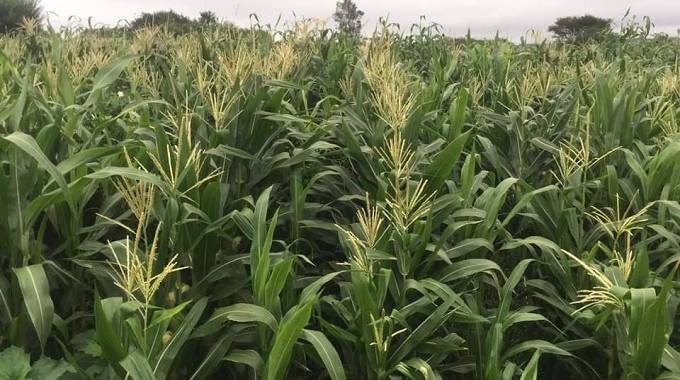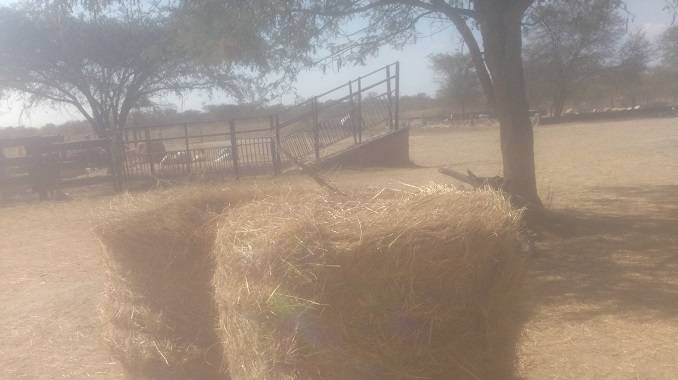
The Sunday News

Gabriel Masvora
FROM the car window, the surrounding landscape looks brown, in some cases bare and dusty. A few shrubs and trees here and there but what cannot be mistaken is the little grass that the livestock- from cattle, donkeys and few goats- are foraging for the day’s meal.
Signs are clear that the animals have eaten everything that they can reach for, from grass, the little leaves hanging from the shrubs and even tree barks. Such is the spectacle anyone is confronted with when driving along numerous roads that cut across the belly of Matabeleland region, a relatively dry region in Zimbabwe.
Most farmers in the region rely on livestock farming and growing small grains to mitigate effects of low rainfall but even these farming activities have come under serious threat from the vagaries on climate changes which have threatened to suck the life out of even the most resilient farmers.

Intercropping … A field of maize and sorghum that will be used for silage at the farm
But instead of mourning and groaning over the depleting pastures and loss of livestock and even livelihood, some farmers have begun to see a silver lining beyond the adverse effect of climate change. The farmers are increasingly adopting Climate Smart Agriculture to circumvent the hazards that have threated their business enterprises.
Climate Smart Agriculture (CSA) is defined as agricultural practices that sustainably increase productivity and system resilience. It ensures that climate change adaptation and mitigation are directly incorporated into agricultural development planning and investment strategies.
One such farmer is Mr Obert Chinhamo of Biano Farm, situated about 30 kilometres from Bulawayo in Esigodini. Although his main business is into livestock farming where he breeds a herd of more than 300 Simmentals cattle, he has adopted a number of climate change mitigation initiatives that have complemented his main business venture.

Mr Obert Chinhamo
“I have a rain gauge at the farm, and if you look at the figures we have been collecting over the 10 years, it is clear that the amount of rainfall is getting little every year, in fact the seasons are also getting shorter,” said Mr Chinhamo who is also the chairman of the Simmental Society of Zimbabwe.
The society is an exclusive club of livestock breeders with only six members in Zimbabwe who breed that type of cattle. Being in such an exclusive club means a farmer needs various initiatives to deal with the effects of drought and pasture depletion to maintain the status.
Mr Chinhamo said his farm is home to composite climate change mitigation initiatives, all interwoven to ensure that the farm remains a shining beacon despite being located in the dry region that has been hit by numerous droughts.
“On one part of the farm we grow pastures for our cattle. We grow the Katambora Rhodes grass which we then graze to the cattle or we sometimes bale it so that we can feed the cattle during the dry season,” he said.

Hay bales used during the dry season to feed the cattle
According to a research that was done for the Centre for Coordination of Agricultural Research and Development for Southern Africa (CCARDESA), an organisation that was formed to harmonise the implementation of agricultural research and development in the Sadc region, hay is not just key in fodder management to deal with climate change shocks.
It is nematode resistant and suppressive and is key in restoring soil structure, improving soil organic levels and creating a good ground cover and effectively controls soil erosion. It is also highly salt and fire tolerant and can establish easily.
Apart from the Katambora grass, the innovative farmer also has an area where he grows another fodder crop Lucene grass, which is also a drought resistant grass, highly recommended for livestock farmers.
“With lucerne, it is a seven year crop so most of the time we let it grow from rain water, we normally harvest it twice during the rainy season and store in it rooms using dry windows where we also add mabiko protein to boost nutrient content and feed the cattle during the dry season.”
The grass is a deep-rooted, nitrogen-fixing crop that has high protein and most farmers prefer it since once it germinates, it grows naturally. It also has energy value and like most legumes its roots contain nitrogen-fixing bacteria that help in increasing nitrogen content in the soil.
“But we are not only into growing pastures, we’re also silaging where we do inter-cropping of a variety of sorghum varieties such as sugar graze and shirikure (indigenous) which we intercrop with maize. Averagely we get 45 tonnes of sorghum per hectare and about 50 tonnes of maize per hectare which we then mix in making silage,” he said.
In this case, inter-cropping is not just being explored to provide ingredients for silage but experts also point to a variety of other advantages of the method in agriculture.
Apart from giving more crops per land area, farmers can produce in such a way that the yield is not lowered compared to when one crop is grown alone. Although research has shown that managing two crops on one piece of land can be difficult, agriculturalists have noted that inter-cropping has the advantage of improving ground cover and hence prevents soil erosion which would otherwise be increased by wind in drought years. Despite engaging in all these drought mitigation initiatives, Mr Chinhamo’s main goal is still on livestock rearing.
“Most livestock farmers in this region tend to rely on stock feed during droughts. I have never bought stock feed, all my feed comes from the same farm,” he said.
A 50 kilogramme bag of stock feed in most shops in Bulawayo costs at least US$15, meaning a farmer needs around U$$300 to buy a tonne of stock feed.
“For me I only need the seed, the fertiliser and labour to produce my stock feed, and I can assure you that to produce a tonne of stock feed I don’t need US$300. All livestock farmers must look beyond just the livestock but also come up with initiatives that augur well with the region to ensure they have feed to sustain their herds during droughts.”
Farmers have also complained that the price of stockfeed in shops is expensive but as Mr Chinhamo observes, if every farmer can produce their own feed or at least a part of it, then the price will go down. Biano Farm besides being home to more than 300 high quality Simmental breeds of cattle, is a clear testimony that a composite fodder management programme can easily mitigate the effects of drought that has been brought about by climate change in most parts of Africa.
A well-managed and complementing programme in fodder management can increase productivity and eventually income.
Such sound soil management practices on the land can produce high-yielding and quality pastures that can be consumed green or preserved through various means for future use.
Fodder management can therefore also help enhance resilience or adaptation of livelihoods and ecosystems towards climate extremes.
Adopting fewer droughts affected, fodder species increase the drought resilience of livestock farmers. Storage methods like hay or silage further decrease drought vulnerability because even if the fodder crops dry out, a certain stock is still available to survive the worst drought months.



